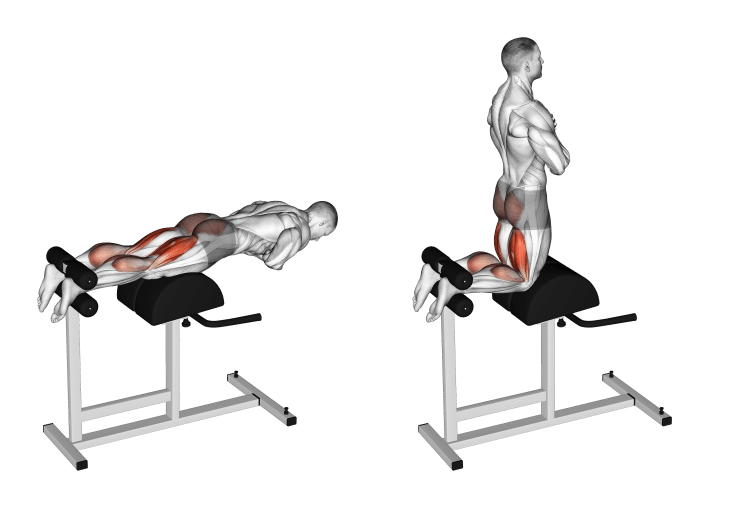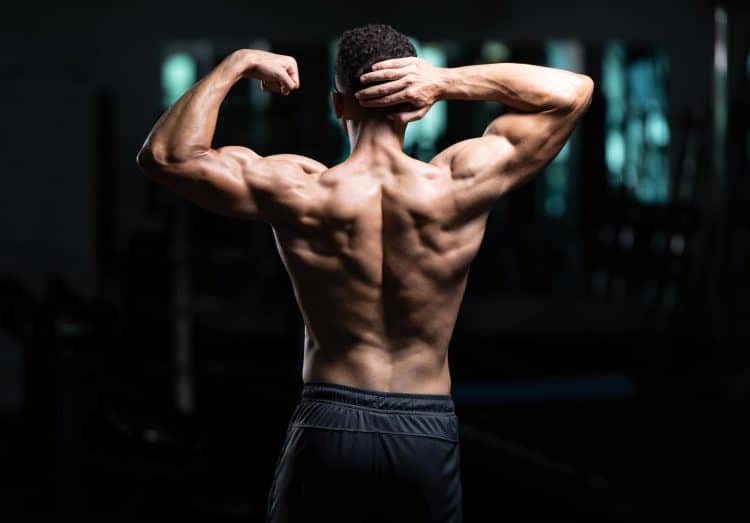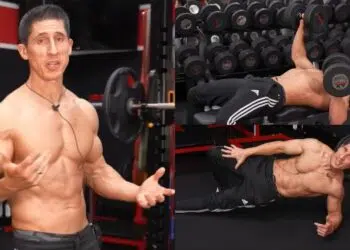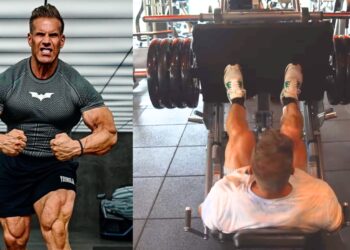Most people like to train their mirror muscles. What are those, you ask? These are the muscles that you can look at in the mirror while training them, such as the biceps, shoulders, chest, abs, and quadriceps. Looking at your pumped-up muscles in the mirror makes you want to train them more often.
On the other hand, since you cannot look at your posterior chain muscles, such as the back, glutes, hamstrings, and calves, it makes it more difficult to establish a mind-muscle connection with them. Since most people fail to achieve optimal muscle fiber stimulation and contraction while training their posterior chain muscles, it is usually a lagging muscle group for them.
That said, the posterior chain muscles, such as the glutes, back, and hamstrings are some of the biggest muscle groups in your body. Overlooking training them can lead to strength and muscle imbalances and increase your risk of injury.
The GHD machine was developed to fix this issue. This ordinary-looking bench is one of the most versatile pieces of training equipment. An exerciser can perform several exercises on the GHD machine to improve their posterior chain.
Most people use ‘GHD’ glute-hamstring developer and ‘GHR’ glute-hamstring raise interchangeably. By making this mistake, these folks limit the possibilities of what they can achieve with this machine.
In this article, we go over everything you must know to make the most of the GHD machine, including the different exercises you can perform, the muscles worked, its benefits, common mistakes, and the best variations and alternatives. We have a lot to cover, so sit tight and read on.
Level Up Your Fitness: Join our 💪 strong community in Fitness Volt Newsletter. Get daily inspiration, expert-backed workouts, nutrition tips, the latest in strength sports, and the support you need to reach your goals. Subscribe for free!
What is GHD?
The glute-hamstring developer, popularly known as the GHD, is a hyperextension alternative. This isolation exercise builds endurance, strength, and muscle mass in the posterior chain (read: hamstrings, glutes, and lower back).
The GHD machine has become a mainstay in CrossFit gyms worldwide because of its effectiveness. The meteoric rise of CrossFit since 2014 has also led to the popularity of the GHD machine.
In contrast to the hyperextension machine, which usually has its thigh pads set at a 45-degree angle, the GHD machine has its pads parallel to the floor. This setup puts more demands on your posterior chain muscles.
Best GHD Exercises & How To Do Them
There are four main GHD machine exercises you must do to take your posterior chain gains to the next level. These exercises might look the same to an untrained eye. However, this guide will help you differentiate between them and learn the correct form to maximize results.
GHD Glute-Ham Raise (GHD Raise)
The GHD raise is one of the most popular GHD exercises, and it is the exercise most people are referring to while talking about GHDs. Glute-hamstring raises were allegedly developed by the Soviet Union weightlifting team to maximize their snatch and clean and jerk performance. As the name suggests, this exercise helps focus on the glutes and hamstrings.
How To Do the GHD Raise:
- Mount the machine and place your knees on the support pads just shy of the center. Your hips should be over the pads at the bottom of the movement.
- Hold onto the pads while you get into position.
- Anchor your ankles between the foot pads.
- Your lower legs should be parallel to the floor, and your torso should be 90 degrees with it.
- Hold your hands in front of your chest and keep your back neutral throughout the exercise. This will be your starting position.
- Take a deep breath, brace your core, and slowly lean your torso forward by extending your knees until it is parallel to the floor.
- Breathe out sharply and flex your knees to return to the starting position.
- Focus on contracting your glutes and hamstrings throughout the range of motion.
- Repeat for the recommended reps.
Pro Tip: Your body, from the top of your knees to your head, should be in a straight line throughout the exercise. Avoid hinging your hips or rounding or overarching your back during this lift.
GHD Hip Extension
The GHD hip extension focuses on your glutes and is one of the best isolation exercises for folks with a lagging bum. You will also experience greater lower back engagement in this GHD variation.
How To Do the GHD Hip Extension:
- Adjust the foot platform so that your hips are entirely off the support pads during the exercise.
- Get on the GHD machine and place your feet between the foot pads.
- Your feet should be pointing straight down during the exercise. Angling out your feet will put unnecessary strain on your adductors.
- Cross your arms in front of your chest.
- Lower your torso toward the floor so that your body is perpendicular to the floor, also known as the Superwoman position. Again, your hips should be off the pads. This will be your starting position.
- Take a deep breath, brace your core, and lower your torso until it is almost perpendicular to the floor.
- Contract your glutes and return to the starting position.
- Rinse and repeat.
Pro Tip: Avoid breaking parallel during concentrics as it can remove tension from your glutes and put it on your lower back and hamstrings. Keep your shoulder blades pulled back and down and your chest proud throughout this exercise.
GHD Back Extension
The GHD back extension is a combination of the GHD raise and the GHD hip extension in that you will use the setup of the former, whereas you will follow the range of motion of the latter. That said, the focus of this exercise is your lower back. Your glutes and hamstrings will function as supporting muscles.
Since you’ll focus on your lower back in this exercise, you must round your back during eccentrics (lowering movement) and unfurl your back during concentrics.
How To Do the GHD Back Extension:
- Adjust the foot pads so that the top of your hips is above the center of the pad.
- Mount the GHD machine and place your ankles between the foot pads.
- Cross your arms in front of your chest and get into a Superwoman position so your body is parallel to the floor.
- Initiate the movement by tucking your chin into your upper chest.
- Slowly round your back, one vertebra at a time, and lower your torso toward the floor.
- Your belly should be wrapped around the top end of the pad at the bottom of the movement.
- Reverse the movement to return to the starting position.
- Squeeze your lower back during concentrics.
- Keep the movement slow and controlled to avoid engaging your glutes and hamstrings.
Pro Tip: Compared to the hip extension, the back extension helps keep your hips static, putting more tension on your lower back.
GHD Hip and Back Extension
This is arguably the most complex GHD variation, as it combines everything you have learned up to now. You will experience greater glute and lower back engagement in this exercise, whereas your hamstrings will take a back seat.
Since this exercise has more moving parts than the previous GHD variations, you might need some time to master this exercise.
How To Do the GHD Hip and Back Extension:
- Bring the foot pads close to the main support pads, as your hips should be clear of the pads during this exercise.
- Get on the GHD machine and put your ankles between the foot pads.
- With your arms crossed in front of your chest, assume the Superwoman position. Your hips should be clear off the pads, and your body should be in a straight line and parallel to the floor at the starting position.
- Begin the movement by tucking your chin into your upper chest.
- Slowly roll your shoulders, then your upper back, as you lower your torso toward the floor. Your upper body should be rounded and parallel to the floor at the bottom of the position.
- At this position, arch your back and neutralize your spine.
- Round your back again and reverse the motion by extending your hips to return to the starting position.
- Contract your hips and lower back during concentrics.
Pro Tip: Since the last two exercises require rounding the spine, you should avoid using additional resistance on these GHD variations. Instead, focus on training the hips and lower back to failure by performing a hip number of reps.
Muscles Worked During GHD
All the four GHD variations explained above target the posterior chain. However, the primary and secondary working muscles vary for each exercise group. Here are the muscle groups worked with the GHD exercises:
Glutes & Hamstrings
The glutes and hamstrings are the primary target muscles of the GHD raises. The glutes are the biggest and strongest muscle in your body, and training them can improve your overall functionality and workout performance. The GHD machine is one of the best tools to develop your hamstrings.
Lower Back
Most exercises want you to avoid lower back engagement; the GHD is not one of them. Since the GHD exercises involve constant hip flexion and extension, you cannot escape lower back engagement, especially while doing a high number of reps.
Calves
Whether you are working above parallel (GHD raise) or in the lower half (hip and back extensions), you will achieve lower leg stimulation. You will experience your calves fire up to a greater degree in longer sets (more than 15 reps).
Given below is an overview of the primary and secondary muscles of the four GHD variations:
Level Up Your Fitness: Join our 💪 strong community in Fitness Volt Newsletter. Get daily inspiration, expert-backed workouts, nutrition tips, the latest in strength sports, and the support you need to reach your goals. Subscribe for free!
| Exercise | Primary Target Muscles | Secondary Muscles |
| GHD Raise | Glutes and hamstrings | Lower back |
| GHD Hip Extension | Glutes | Lower back and hamstrings |
| GHD Back Extension | Lower back | Glutes and hamstrings |
| GHD Hip and Back Extension | Glutes and lower back | Hamstrings |
Benefits of GHD
Adding the GHD machine to your training regimen entails the following benefits:
Builds Strength and Muscle Mass
The glute-hamstring developer can help you build stronger and more muscular glutes, hamstrings, and lower back. Adjust your training and volume to meet your objective.
Develop a Robust Posterior Chain
A strong posterior chain can improve your overall functionality, training, and athletic performance. Performing this exercise regularly can translate to better performance on compound movements that require posterior chain engagement.
Perfect For Exercisers of all Experience Levels
Since GHD exercises are isolation movements, they are easy to learn. That said, this machine is just as effective for advanced lifters as it is for newbies. Seasoned trainers can add to this exercise’s difficulty by using additional resistance.
Reduces Risk of Hamstring Injury
Research shows that adding eccentric-focused movements and isometric exercises can reduce your risk of injury during explosive movements [1]. People that deal with recurring posterior chain injuries should add this exercise to their exercise regimen after consulting their healthcare provider.
Common Mistakes While Performing GHD
Avoid committing the following errors to limit the risk of injury and get the best bang for your buck:
Replacing the GHD Machine with a Hyperextension Bench
Many people think that 45-degree hyperextension machines are the same as GHD machines. However, nothing could be further from the truth. The GHD machine is much more demanding on your hamstrings and glutes than the hyperextension bench.
Mixing Two GHD Movements
I cannot tell you how often I see people do GHD raises with a GHD hip extension setup. Remember, going all the way up, and all the way down is not always a good idea. You must get well-versed with the GHD variations to reduce your risk of injury.
Adding Weights Too Soon
Bodyweight versions of the GHD variations explained in this article are good enough for most people to build a strong and muscular posterior chain. You should only use additional resistance after you have drilled the movement.
Variations of GHD
Use the following GHD variations to add variety to your exercise regime:
Eccentric-Focused Glute-Ham Raise
You can use this technique in any of the four GHD variations mentioned in this article. In this exercise, you take three to five seconds on the eccentrics. Slowing down the negatives increases the time under tension, which leads to greater muscle stimulation [2]. Follow the same-old rep tempo during concentrics and the statics contraction points at the top and bottom.
Sorenson Hold
The Sorenson hold is an isometric GHD variation, meaning you hold the same position for a specific time. Think of the Sorenson hold as a plank for your glutes, hamstrings, and lower back.
How To:
- Get in the same position as the GHD hip extension. Your hips should be clear of the pads.
- Cross your arms in front of your chest.
- Extend your hips and lower your torso so your body is parallel to the floor.
- Hold this position for as long as possible. Aim for 30-60 seconds.
- Repeat for recommended reps.
GHD Oblique Crunch
This GHD variation works your obliques and can help you develop shredded obliques and the coveted sex lines.
How To:
- Adjust the foot pads of the GHD machine so that your hips rest on top of the pads.
- Mount the GHD machine. Turn to your side so that your right shoulder is facing the ceiling. The side of your left hip should be on the left pad.
- Secure your left foot between the foot pads and place your right foot on top of the pads.
- Your body should be in a straight line and parallel to the floor at the starting position.
- Lower your torso as low toward the floor as possible.
- Return to the starting position.
- Repeat for recommended reps before switching sides.
Alternatives of GHD
Here are some of the best alternatives to the GHD:
Nordic Curl
You could perform this exercise on a specialized Nordic curl or with a barbell. Since most people don’t have access to a Nordic curl bench, here is how to do this movement with a barbell.
How To:
- Attach two-quarter plates on each end of a barbell and place them on the floor.
- Kneel on the floor facing away from the bar and anchor your heels under it.
- Your body, from your knees to your head, should be in a straight line at the starting position.
- Hold your hands in front of your chest.
- Slowly lower your torso toward the floor by leaning forward. Control the descent by contracting your hamstrings and glutes.
- Break the fall with your hands.
- Use your hands for a lift-off. Contract your glutes and hamstrings to return to the starting position.
- Repeat for recommended reps.
Reverse Hyperextensions
This exercise flips the GHD hip extension on its head. Louie Simmons on Westside Barbell invented reverse hyperextension and a specialized machine for it. However, you can use a GHD machine for this exercise.
How To:
- Stand facing the GHD machine.
- Reach forward and grab the foot platform. Adjust the platform so your hips are hanging off the pads.
- At the starting position, your body should be in a straight line and parallel to the floor.
- Lower your legs toward the floor until they are a few inches from touching it.
- Keeping your legs straight, extend your hips and raise your lower body as high toward the ceiling as possible.
- Control the descent.
- Repeat for recommended reps.
Good Morning
Good mornings are an incredibly effective exercise to work your posterior chain. Use a moderate weight on this exercise to limit the risk of injury.
How To:
- Stand upright with a hip-width stance with a barbell across your shoulders.
- Maintaining a slight bend in your knees, slowly lower your torso toward the floor while pushing your hips back. Keep your core braced throughout the exercise.
- Your torso should be almost parallel to the floor at the bottom of the position.
- Return to the starting position.
Romanian Deadlift
The Romanian deadlift is a compound full-body exercise to build overall strength and muscle mass. However, this exercise primarily targets the glutes, hamstrings, and lower back.
How To:
- Stand straight with a shoulder-wide stance while holding a barbell against your thighs using an overhand grip.
- Maintaining a slight bend in your knees, slowly lower the bar toward the floor by bending at your hips and pushing them back.
- The bar should be below your knees at the bottom of the range of motion.
- Pause at the bottom and contract your hamstrings and glutes.
- Explode back to the starting position.
- Rinse and repeat.
FAQs
Who should avoid the GHD raises?
Folks dealing with posterior chain or lower body injuries should avoid the GHD raises. That said, you should consult your healthcare provider before starting a new training or nutrition program, especially if you’re suffering from a health issue, are pregnant, or are under 18 years old.
Can I replace leg curls with GHD raises in my workout?
Leg curls and GHD raises are both isolation exercises that work the hamstrings. However, GHD also targets your glutes. On the other hand, the leg curl machine helps maintain constant tension on your hammies throughout the range of motion. Each machine has its unique benefits, and hence you should include both in your training regimen.
How often should I do the GHD raise?
Since GHD raises are an isolation exercise, they put incredible demand on your hamstrings. According to research, you must give your muscles at least 48 hours to recover between workouts. It will result in better strength and muscle gains and reduce your risk of injury and overtraining. [3]
Who should do the GHD exercises?
The GHD variations explained in this article are great for CrossFitters, Strongman athletes, Olympic weightlifters, bodybuilders, and even hobbyist exercisers. Building a strong posterior chain help virtually everyone.
Wrapping Up
The GHD machine is a versatile training equipment that can help build a stronger and more muscular posterior chain. It can also help develop a robust midline, using exercises like the GHD sit-ups and oblique crunches.
Folks with access to a GHD machine at their gym should add the four GHD exercises explained in this article to their training regimen. Adjust the programming and training frequency to meet your objectives. So, what are you waiting for? Get working on those glutes and hammies. Best of luck!
References
- Jonhagen S, Nemeth G, Eriksson E. Hamstring Injuries in Sprinters: The Role of Concentric and Eccentric Hamstring Muscle Strength and Flexibility. The American Journal of Sports Medicine. 1994;22(2):262-266. doi:10.1177/036354659402200218
- Burd NA, Andrews RJ, West DW, Little JP, Cochran AJ, Hector AJ, Cashaback JG, Gibala MJ, Potvin JR, Baker SK, Phillips SM. Muscle time under tension during resistance exercise stimulates differential muscle protein sub-fractional synthetic responses in men. J Physiol. 2012 Jan 15;590(2):351-62. doi: 10.1113/jphysiol.2011.221200. Epub 2011 Nov 21. PMID: 22106173; PMCID: PMC3285070.
- Monteiro ER, Vingren JL, Corrêa Neto VG, Neves EB, Steele J, Novaes JS. Effects of Different Between Test Rest Intervals in Reproducibility of the 10-Repetition Maximum Load Test: A Pilot Study with Recreationally Resistance Trained Men. Int J Exerc Sci. 2019 Aug 1;12(4):932-940. PMID: 31523350; PMCID: PMC6719818.
Interested in measuring your progress? Check out our strength standards for Good Morning, Sit Ups, Clean, and more.











